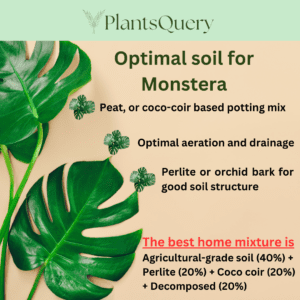Monstera deliciosa, also known by its common names Split-Leaf Philodendron or Swiss Cheese Plant, belongs to the Araceae family (1). The moniker “monstera” is derived from the monstrous holes and splits present in its substantial leaves. This ornamental plant bears evergreen leaves of impressive dimensions, measuring up to a remarkable 36 inches in both length and width. Proper optimal soil for monstera for its good growth is a coco-coir-based potting mix, perlite, and agricultural-grade soil. The leaves are characterized by their distinct holes and splits, adding to the plant’s aesthetic allure. These vines are capable of reaching 30 feet or more in length but can easily be kept shorter by trimming the terminal new growth. Smaller plants grown in containers totem poles are quite popular as interior plants.
In essence, the Monstera deliciosa is a remarkable plant, not only for its visually striking features but also for its adaptability to different growing conditions. Its captivating leaves and ability to thrive both indoors and outdoors make it a favorite amongst gardeners and plant enthusiasts seeking to elevate the aesthetic of their living spaces.
Botanical description
Leaves
Its large, thick, leathery leaves are glossy dark green when mature, measure 2–3 ft long, and are deeply cut and perforated with oblong holes. The leaf stems can be as long as 3 ft. Leaves of young, juvenile plants are uncut and smaller, and this form is often called Philodendron pertusum.
Flowers
Numerous flowers occur in a spike and, except for a few sterile ones near the base of the spike, the flowers are perfect (containing both male and female parts). The flower spike is surrounded by a white, boat-like bract. The flowers are not showy.
Fruits
Monstera is well known for its long, cone-shaped, edible fruits about 8 x 2 inches in size. The fruits are made up of numerous cohering berries. The mature fruit has a yellow-green, violet-spotted rind of hexagonal plates covering a creamy-white, soft pulp having a flavor like a mixture of banana and pineapple.
Monstera care
Light
This plant thrives best under bright indirect light. Place the plant near the window under the north or east-facing light. Direct sunlight can scorch their leaves.
Air
keep the plant in a place that is good and airy not congested.
Water
Only water after the topsoil about an inch dries up. Just ensure that the soil is constantly moist but not overmoist or water-logged. Based on the season the frequency of watering should be adjusted that is during warmer seasons water more and during the winter season water less.
Temperature and humidity
Monstera plants being tropical need a warm and humid environment. Keep the temperature between 18-29 °C (65-85 °F). Spray or mist is necessary for the plant, especially in drier climates.
Fertilization
Need regular feeding, especially during the growing season. Reduce fertilizers during the fall and winter when the growth slows down.
Optimal soil for monstera

Use a well-draining, peat, or coco-coir-based potting mix to provide optimal aeration and drainage for the Monstera roots. Adding perlite or orchid bark can help improve soil structure.
Whatever proportion you are going to use just make sure the soil is well well-drained and aerated as this is very crucial for the plant and is important for its healthy root and good growth.
The following components can be used for making optimal soil for monstera
1. Coco Coir
Also known as coconut coir is a natural environment-friendly fiber from the husk of coconuts. This material is eco-friendly and is a good alternative to peat moss and other soilless growing media which provide moisture.
2. Perlite
As the monstera plant needs to have a proper drainage and aeration system, hence perlite is good and can become a part of optimal soil preparation for monstera.
3. Agricultural-grade soil
This type of soil helps in improving drainage and prevents clogging and chocking of the root as provides sufficient space for the air and prevents the soil from becoming too compact.
4. Decomposed compost
In the end, do not forget to add well-decomposed compost as it helps in enhancing the organic matter of the potting mixture and gives nutrients to the soil.
How to create optimal soil for monstera
The best home mixture for monstera is agricultural-grade soil (40 %) with perlite and coco coir and decomposed (20% each). Mix them well and break up if there are any clumps. Maintain the moisture by checking the topsoil.
Things to look
- Avoid heavy soil or soil with poor aeration and high moisture holding capacity.
- Regular repotting every 2 years is good for the proper growth of the monstera plant.
- Fertilize during the growing season, I prefer organic fertilizer of 4-5 tablespoons per plant.
- maintain the moisture level by regular spraying or keeping the plant over a water tray.
